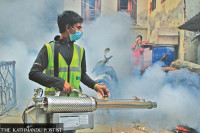Health
Multiple omicron subvariants responsible for latest Covid surge
Subvariants—XFG, XFG.3. JN.1—have been confirmed in swab samples of infected persons through whole-genome sequencing.
Post Report
Nepal on Monday confirmed the spread of multiple subvariants of the Omicron variant of the coronavirus.
Of the 14 swab samples of Covid-infected persons on which whole-genome sequencing was carried out recently, omicron subvariants were detected in all.
According to the National Public Health Laboratory, which carried out the whole genome sequencing, the subvariant XFG was confirmed in seven samples, XFG.3 in five samples, and JN.1 in two samples.
The omicron’s subvariants XFG and XFG.3 are also the dominant strains spreading in neighbouring India.
The NPHL said that NB.1.8.1 was not detected in any of the samples.
Whole-genome sequencing is a comprehensive method of analysing the entire DNA sequence of an organism’s genes. Researchers believe that whole-genome sequencing of the coronavirus could be instrumental in tracking the severity and properties of the virus.
Nepal confirmed new coronavirus cases recently on June 4, when three people—two males and a female—who returned from India tested positive.
According to the Epidemiology and Disease Control Division, 180 people from 25 districts have tested positive for Covid since January. At least 25 people tested positive for the deadly virus in the past one week alone. The number of people testing positive to the virus in the last 24 hours stands eight
However, people had been getting infected with the virus since the start of the year, as the virus had already become endemic in Nepal.
Health officials say that rapid diagnostic testing is being carried out only on those having coronavirus-like symptoms—fever, cough, sore throat, among others.
Testing is not being carried out on asymptomatic people who might be infected. Some might have come during the incubation period, but no agency in the country tracks their movements. Health workers say they have asked the infected people to remain in isolation for five days and let them go home from the border entry points.
The Health Ministry officials also said they have started procedures to purchase rapid diagnostic test kits, which are in limited supply.
India has reported a steady decline in the number of active cases recently. According to media reports, India’s active caseload dropped to 5,012 on Sunday, down from 5,976 on Friday.
Thousands of people from both countries enter each other’s territories every day on top of the large number of those who use unregulated points along the porous border.
Experts say almost all variants of the coronavirus outbreak in India have found their way into Nepal. They say that even if the latest omicron subvariants are not as deadly as other variants, the virus still poses a serious threat to the elderly and people with compromised immunity.




 25.12°C Kathmandu
25.12°C Kathmandu














